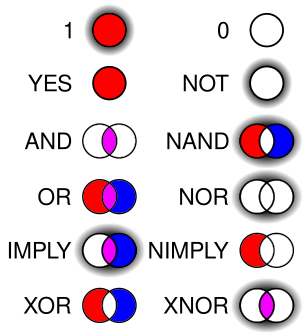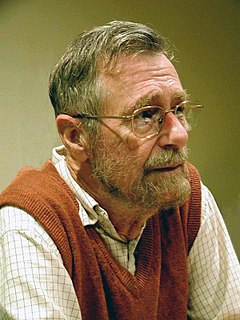Automated theorem proving is a subfield of automated reasoning and mathematical logic dealing with proving mathematical theorems by computer programs. Automated reasoning over mathematical proof was a major impetus for the development of computer science.
A specification language is a formal language in computer science used during systems analysis, requirements analysis, and systems design to describe a system at a much higher level than a programming language, which is used to produce the executable code for a system.
In computer science, specifically software engineering and hardware engineering, formal methods are a particular kind of mathematically based technique for the specification, development and verification of software and hardware systems. The use of formal methods for software and hardware design is motivated by the expectation that, as in other engineering disciplines, performing appropriate mathematical analysis can contribute to the reliability and robustness of a design.
In computer science, model checking or property checking is, for a given model of a system, exhaustively and automatically checking whether this model meets a given specification. Typically, one has hardware or software systems in mind, whereas the specification contains safety requirements such as the absence of deadlocks and similar critical states that can cause the system to crash. Model checking is a technique for automatically verifying correctness properties of finite-state systems.
In computer science, program synthesis is the task to automatically construct a program that satisfies a given high-level specification. In contrast to other automatic programming techniques, the specifications are usually non-algorithmic statements of an appropriate logical calculus. Often, program synthesis employs techniques from formal verification.
Extended ML is a wide-spectrum language covering both specification and implementation and based on the ML programming language. It extends the syntax of ML to include axioms, which need not be executable but can rigorously specify the behavior of the program. With this addition the language can be used for stepwise refinement, proceeding gradually from an initial formal specification to eventually yield an executable Standard ML program. Correctness of the final executable SML program with respect to the original specification can then be established by proving the correctness of each of the refinement steps. Extended ML is used for research into and teaching of formal program development and specification, and research into automatic program verification.

Logic in computer science covers the overlap between the field of logic and that of computer science. The topic can essentially be divided into three main areas:
Refinement is a generic term of computer science that encompasses various approaches for producing correct computer programs and simplifying existing programs to enable their formal verification.
In computer science, formal specifications are mathematically based techniques whose purpose are to help with the implementation of systems and software. They are used to describe a system, to analyze its behavior, and to aid in its design by verifying key properties of interest through rigorous and effective reasoning tools. These specifications are formal in the sense that they have a syntax, their semantics fall within one domain, and they are able to be used to infer useful information.
Clifford "Cliff" B. Jones is a British computer scientist, specializing in research into formal methods. He undertook a late DPhil at the Oxford University Computing Laboratory under Tony Hoare, awarded in 1981. He also worked with Dines Bjørner and others on the Vienna Development Method (VDM) at IBM Laboratory Vienna.
In computer science, an abstract state machine (ASM) is a state machine operating on states that are arbitrary data structures.
The refinement calculus is a formalized approach to stepwise refinement for program construction. The required behaviour of the final executable program is specified as an abstract and perhaps non-executable "program", which is then refined by a series of correctness-preserving transformations into an efficiently executable program.
Professor James Charles Paul Woodcock FREng FBCS CEng CITP is a British computer scientist.
A computer-assisted proof is a mathematical proof that has been at least partially generated by computer.
Proof-carrying code (PCC) is a software mechanism that allows a host system to verify properties about an application via a formal proof that accompanies the application's executable code. The host system can quickly verify the validity of the proof, and it can compare the conclusions of the proof to its own security policy to determine whether the application is safe to execute. This can be particularly useful in ensuring memory safety.

Matita is an experimental proof assistant under development at the Computer Science Department of the University of Bologna. It is a tool aiding the development of formal proofs by man-machine collaboration, providing a programming environment where formal specifications, executable algorithms and automatically verifiable correctness certificates naturally coexist.

Edsger Wybe Dijkstra was a Dutch systems scientist, programmer, software engineer, science essayist, and pioneer in computing science. A theoretical physicist by training, he worked as a programmer at the Mathematisch Centrum (Amsterdam) from 1952 to 1962. A university professor for much of his life, Dijkstra held the Schlumberger Centennial Chair in Computer Sciences at the University of Texas at Austin from 1984 until his retirement in 1999. He was a professor of mathematics at the Eindhoven University of Technology (1962–1984) and a research fellow at the Burroughs Corporation (1973–1984).
Charles Carroll Morgan is an American computer scientist who moved to Australia in his early teens. He completed his education there, including a PhD degree from the University of Sydney, and then moved to the United Kingdom in the early 1980s. In 2000, he returned to Australia.
Eric C.R. Hehner, called Rick, is a Canadian computer scientist. He was born on 16 September 1947 in Ottawa. He studied mathematics and physics at Carleton University, graduating in 1969. He gained a PhD in computer science from the University of Toronto in 1974. He then joined the faculty there, becoming a full professor in 1983. He became the Bell University Chair in Software Engineering in 2001, and retired in 2012.





